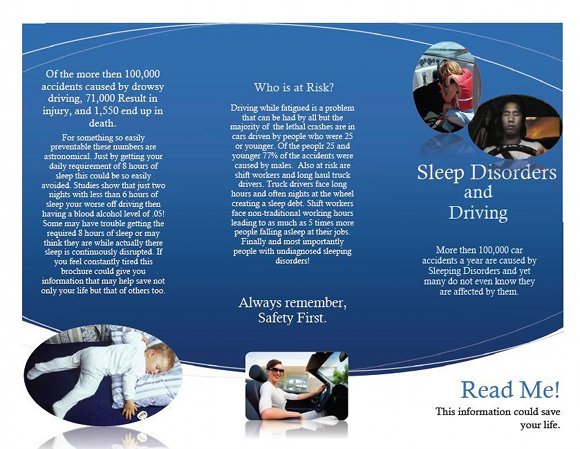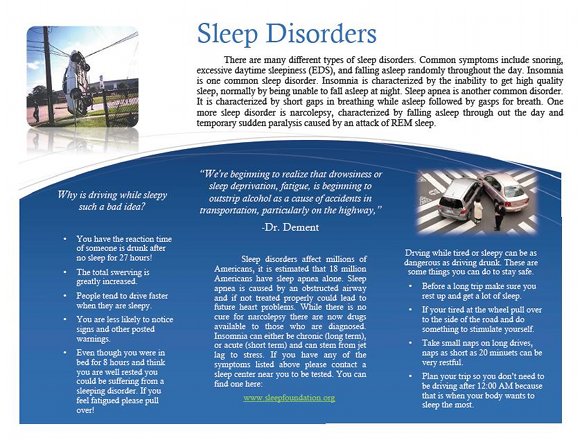
| Connect & Subscribe |
Sleep Disorders and Driving Brochure
An Outreach Project by Blake Crowe | Return To Outreach Projects 2010
The following is a brochure created for Stanford Sleep and Dreams. If it is difficult to read using the images, you may view the full text here.
Also feel free to download this brochure for distributional or general information purposes. Please refer to our privacy policy for our relevant disclaimers.


Sleep Disorders and Driving
Of the more then 100,000 accidents caused by drowsy driving, 71,000 Result in injury, and 1,550 end up in death.
For something so easily preventable these numbers are astronomical. Just by getting your daily requirement of 8 hours of sleep this could be so easily avoided. Studies show that just two nights with less than 6 hours of sleep your worse off driving then having a blood alcohol level of .05! Some may have trouble getting the required 8 hours of sleep or may think they are while actually there sleep is continuously disrupted. If you feel constantly tired this brochure could give you information that may help save not only your life but that of others too.
Who is at Risk?
Driving while fatigued is a problem that can be had by all but the majority of the lethal crashes are in cars driven by people who were 25 or younger. Of the peoplr 25 and younger 77% of the accidents were caused by males. Also at risk are shift workers and long haul truck drivers. Truck drivers face long hours and often nights at the wheel creating a sleep debt. Shift workers face non-traditional working hours leading to as much as 5 times more people falling asleep at their jobs. Finally and most importantly people with undiagnosed sleeping disorders!
Always remember, Safety First.
More then 100,000 car accidents a year are caused by Sleeping Disorders and yet many do not even know they are affected by them.
Read Me!
This information could save your life.
Sleep Disorders
There are many different types of sleep disorders. Common symptoms include snoring, excessive daytime sleepiness (EDS), and falling asleep randomly throughout the day. Insomnia is one common sleep disorder. Insomnia is characterized by the inability to get high quality sleep, normally by being unable to fall asleep at night. Sleep apnea is another common disorder. It is characterized by short gaps in breathing while asleep followed by gasps for breath. One more sleep disorder is narcolepsy, characterized by falling asleep through out the day and temporary sudden paralysis caused by an attack of REM sleep.
Why is driving while sleepy such a bad idea?
You have the reaction time of someone is drunk after no sleep for 27 hours!
The total swerving is greatly increased.
People tend to drive faster when they are sleepy.
You are less likely to notice signs and other posted warnings.
Even though you were in bed for 8 hours and think you are well rested you could be suffering from a sleeping disorder. If you feel fatigued please pull over!
"We're beginning to realize that drowsiness or
sleep deprivation, fatigue, is beginning to
outstrip alcohol as a cause of accidents in
transportation, particularly on the highway."
- -Dr. Dement
Sleep disorders affect millions of Americans, it is estimated that 18 million Americans have sleep apnea alone. Sleep apnea is caused by an obstructed airway and if not treated properly could lead to future heart problems. While there is no cure for narcolepsy there are now drugs available to those who are diagnosed. Insomnia can either be chronic (long term), or acute (short term) and can stem from jet lag to stress. If you have any of the symptoms listed above please contact a sleep center near you to be tested. You can find one here: www.sleepfoundation.org
Drving while tired or sleepy can be as dangerous as driving drunk. These are some things you can do to stay safe.
Before a long trip make sure you rest up and get a lot of sleep.
If your tired at the wheel pull over to the side of the road and do something to stimulate yourself.
Take small naps on long drives, naps as short as 20 minuets can be very restful.
Plan your trip so you don't need to be driving after 12:00 AM because that is when your body wants to sleep the most.
About This Site
Welcome! This site is continuously being created by students of Dr. William C. Dement's Sleep And Dreams course at Stanford University.
We made this site as a call to action for people all over the world to live healthier, happier, safer, and more productive lives by learning about their own sleep. We have faith that reading the information provided on this site will motivate you to be smart about your sleep deprivation and strategic about your alertness in order to live life to your fullest, most energetic potential.
In fact, we challenge you to do so! What do you say, are you up for the challenge?
Interviews With Sleep Specialists: Insights Into the Worlds of Sleep Medicine & Sleep Business
America's Most Dangerous Disorder: What Is Sleep Apnea Doing To Your Sleep?
Sleep Debt: How Much More Will You Achieve When You Reduce Yours?
The Stages Of Sleep: The Journey Through The Night
Delayed Sleep Phase: You Want To Sleep But You're Not Tired Yet
Paralyzed at Night: Is Sleep Paralysis Normal?
Sleep In Words: Smart, Strange, and Funny Quotes About Sleep
Sleep Disorders In Children: What's Keeping Your Child From A Full Night's Rest?
Attacks of Pavor Nocturnus (a.k.a. Sleep Terrors, Night Terrors, or Incubus Attacks)
The Stanford Sleep Book
Dr. Dement's pioneering textbook has been the core text for Sleep and Dreams since 1980, but it has just recently been made available to the wider public for the first time.
In it you'll find a more detailed account of the most important things you need to know about sleep, alertness, dreams, and sleep disorders. Studies, statistics, plus plenty of Dr. Dement's classic anecdotes painting the history of sleep medicine.
Preface | Intro | Contents | Get A Copy
More Sleep Resources
The Zeo
A revolution in personal sleep tracking, the Zeo is a wireless headband that transmits your brainwaves in realtime to a dock (pictured here) or your smartphone. The result? You can wake up and see exactly what stages of sleep you were in during the night! Unprecedented personalized sleep knowledge.
Sleep Paralysis: A Dreamer's Guide
Ever woken up paralyzed? A surprising number of us have, believe it or not. But few know the actual causes of this phenomenon, and fewer still how to exert control over it. Dream researcher and sleep paralysis expert Ryan Hurd shares breakthrough insights into how to do just that.
Important Disclaimer
Please Note:
The information found on this page and throughout this site is intended for general information purposes only. While it may prove useful and empowering, it is NOT intended as a substitute for the expertise and judgments of healthcare practitioners.
For more info, see our
Terms of Use.









